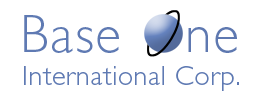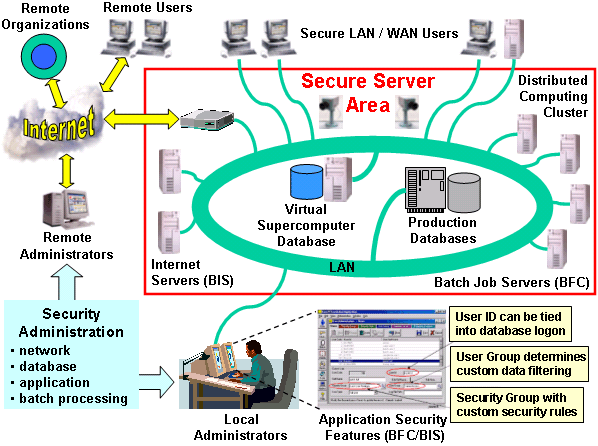 |
.NET database and distributed computing tools |
|
|
|
||||
The Dramatic Story Behind Grid Computing's ROI
| The Deutsche Bank case study provides exceptionally clear, real-world evidence of the substantially lower Total Cost of Ownership (TCO) and higher Return on Investment (ROI) possible with Base One's
grid software, as compared to traditional architectures. Deutsche Bank purchased Bankers Trust, which had a legacy custody system that fulfilled similar requirements and serviced a similar volume of business. In 2000, after Deutsche Bank's securities custody system was placed under the same management responsible for Bankers Trust's system, they compared the continuing expenses and development costs for both systems. |
They found it took a staff of 110 at the equivalent Banker's Trust IBM mainframe system to do the maintenance and operations Deutsche Bank accomplished with only
16 employees, a cluster of rack-mounted PCs, and a mid-priced Solaris Oracle server.
They also discovered that the system built with Base One's database and distributed computing software cost less than one-quarter (25%) as much to develop as the equivalent Banker's Trust application. Banker's Trust's applications were four times more expensive even though they actually did less than Deutsche Bank's, which handled foreign exchange rates and SWIFT messages for financial transactions. What's more, the lower Deutsche Bank costs also included most of the one-time, research and development expense of building Base One's grid software itself. |
Base One Software - Centralized Control, Increased Performance and Security
| Before the Custody Reporting System was built, Deutsche Bank had relied upon a DOS-based system with no user interface, no centralized control, and no application security. The old system also required account reps to manually match the thousands of daily SWIFT affirmations - electronic messages banks use to communicate with each other - by account and to monitor them for missing or incorrect instructions.
The bank wanted to replace its inefficient system with an architecture that was reliable, scalable, and Year 2000 compliant. It also had to be flexible enough to support continuous enhancements by numerous programmers, and capable of being moved into a production environment run by their mainframe data processing staff. |
Using the Base One Foundation Component Library
(BFC), Deutsche Bank built a successful, high-performance Oracle application for reporting on their securities inventory. The Deutsche Bank Securities Custody Reporting System, which includes back-end processing and
application-level security, is far more reliable and robust than their previous system, and the new Windows-based interface gave Deutsche Bank centralized control of its processes for the first time.
The BFC-based Securities Custody Reporting System automatically creates and delivers hundreds of daily client statements plus thousands of SWIFTs. Deutsche Bank regularly updates information from mainframes, creates standard and custom-tailored reports, and distributes them via email, fax and SWIFT-mail to its electronic customers. Once the process was fully automated, account reps no longer had to monitor specific accounts and instead could focus on customer queries. In addition, Deutsche Bank was able to build a repair team that could focus on the exception rather than the entire process. |
DBMS-Independent Architecture Reduced Development Time
| The initial release of the Custody Reporting System went into production in 1997, 12 months after design and implementation began. Because of Base One's DBMS-independent architecture, Deutsche Bank significantly reduced its development time. The development team wanted to use Oracle running on Sun Solaris boxes from the very beginning. However, the slow turnaround from the DBAs led developers to build the entire first release of the custody application on Sybase SQL Anywhere, an inexpensive file-based, database. Six months before the new Oracle software and additional hardware were even installed, Base One's software had made it possible for the bank to finish a prototype using SQL Anywhere. Then, once the Oracle environment was set up, it took only a flip of a switch (a couple of lines in an .INI file) to migrate the prototype into a serious, multi-user Oracle application. |
The Custody Reporting System was able to run database, communication, and reporting jobs 24 hours per day using Base One's
distributed processing and database components
(Batch Job Server, Command Processor, and Data Dictionary). The customizable
Distributed Batch Processing Services were designed for executing potentially long-running tasks on a pool of PCs, creating batch functions and scheduling rules, specifying the hardware characteristics of the PC's doing batch work, and logging task execution milestones. The
Command Processor runs complex scripts that include SQL and DOS commands, plus special commands for loading and unloading large databases. The Custody Reporting System also took advantage of the
Data Dictionary facility, which includes indexing information used to automatically create faster queries.
In addition to software, Base One provided project management as well as design and custom programming for the database, batch processing, and security facilities. Base One consulted with Deutsche Bank's programming staff on Visual C++, SQL, and database performance enhancement. |
User and Database Administration that is Simple and Secure
| Using Base One's tools, Deutsche Bank built a system designed from the start to be operations-friendly. Operators used Base One's System Administration Facility to control and monitor database access, | allowing administrators to force users to log off, restrict logon to certain types of users, and broadcast warning and information messages. |
Here is a diagram of a secure cluster configuration modeled after Deutsche Bank's:

The bank's "virtual supercomputer" - a database plus Windows PCs for grid computing and remote data access
| Base One's class library and middleware made it easy for Deutsche Bank to do database and user administration, set security rules, and submit and monitor batch jobs. The Base One Security System is tied into the back-end DBMS and supports password checking/changing, administrative controls for determining who should be allowed to view sensitive data or perform restricted operations, and custom tailoring of application specific behavior, such as "filtering" data depending on who is looking at it.
In 1999, Deutsche Bank programmers ran successful tests of Base One's Internet Server (U.S. Patent 6,738,775). This was the first proof-of-concept testing to show the practicality of doing a variety of these administrative tasks securely, from remote locations across the Internet. |
The bank's rack-mounted batch machines share a single display, keyboard and mouse. An extra machine is used for submitting jobs and running the Batch Monitor, so that the operator on duty can see how the work is progressing. Deutsche Bank uses these PCs, running Base One's distributed computing software 24 hours per day, to do repetitive back-office operations such as data loads, transformations, exports, database upgrades, and financial reporting.
By combining Base One's batch monitoring tools with a commercial monitoring tool (HP OpenView), the bank was able to achieve the level of error handling and reliability required for enterprise data processing. Such tools are designed for centralized display of the condition of processes running on a large numbers of networked PCs and can, for example, automatically page staff when problems arise. Deutsche Bank used their chosen standard, HP OpenView, to help monitor their production Distributed Batch Processing Services. In combination with Base One's monitoring screens, built-in error logging, and exception handling, this kept the bank's batch production systems running smoothly. |
Base One Number Class Increased Accuracy
| Base One also helped Deutsche Bank overcome problems in numerical accuracy, caused by the transition from its older 16-bit implementation to a fully 32-bit programming environment. The problem was that Microsoft's C++ libraries had actually lowered the maximum precision of floating point numbers from 19 to 16 digits. Add to this the complication of planning for the new Euro currency standard, imposing still further demands on precision, and Deutsche Bank crossed the limits of what could be handled by the conventional 32-bit C++ numeric data types. |
By using the Base One Number Class (U.S. Patent Number 6,384,748), with exact decimal arithmetic up to 100 significant digits of precision, to convert to the 32-bit C++ numeric data types, Deutsche Bank shielded its programmers from the underlying complications, and greatly simplified the transition. Deutsche Bank solved its precision problem quickly, and added safeguards against a variety of calculation errors.
Within a month, Deutsche Bank managers felt so strongly about Base One's Number Class that they instituted a department-wide policy mandating its use throughout all of their applications. |
Deutsche Bank Case Study - Introduction
Visual Studio | Database Technology | Distributed Computing | BFC
|
|
|||||||
| Home | Products | Consulting | Case Studies | Order | Contents | Contact | About Us |
|
|
|||||||
|
Copyright © 2012, Base One International Corporation |
|||||||